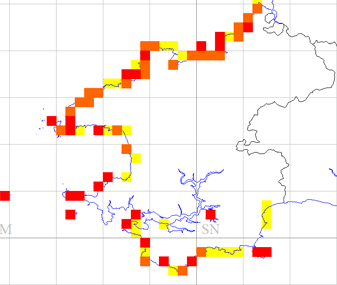Oystercatcher - 2003-07
 Monday, May 7, 2012 at 4:55PM
Monday, May 7, 2012 at 4:55PM In Pembrokeshire oystercatchers are largely restricted to the coast, breeding on rocky shores, sea-cliffs and tops of small islets and larger offshore islands. On the mainland they have a fairly regular, if thinly spread, linear distribution along the coast. However, on the larger islands, Skomer and Skokholm for example, they can form loose colonies at a higher concentration.
Oystercatchers are long-lived birds and it is possible that some of the same birds observed in the 1980s were still breeding in the recent survey period.
Comparing the total number of tetrads in which they were found suggests a small and probably insignificant decline in breeding population distribution between 1984-88 and 2003-07, down by about 13%. Although there was a large decline in the number of tetrads where confirmed breeding was reported, this was more or less balanced by the number of tetrads that registered probable and possible breeding evidence.
Scrutiny of the tetrad distribution map suggests that, although there are fewer tetrads with confirmed breeding, overall there was generally very little change in their distribution on the mainland coast and offshore islands north of Milford Haven. A close look at the map suggests that their distribution has thinned out a little along parts of the south coast.
In 1984-88, it was estimated that there were about 300 pairs of breeding Oystercatchers. At least 50% of these were on the offshore islands, where more regular monitoring is conducted. In 2003-07, the island populations again recorded in the region of 140-160 pairs. This suggests that the Pembrokeshire population is probably reasonably stable, at least in optimal habitat locations.
Monitoring of a small Oystercatcher population along the Castlemartin peninsula, between 2003 and 2007, has provided evidence of 7 – 8 regularly nesting pairs along a 20 km length of limestone coast, covering seven coastal tetrads. Nesting density was quite low and nests were patchily distributed, ranging from one – three per tetrad, but they were absent from some tetrads. Three of these pairs regularly breed at Stackpole each year in one tetrad, in some years with limited success. They are monitored annually and this number has not changed much over the last 20 years.
In 2006, it was reported that in one fairly remote nest, on the shore of Carew River, 8 eggs had been laid which was almost certainly a result of egg dumping involving two females.
Based on 76 tetrads where Oystercatchers were found along the mainland coast of Pembrokeshire, an average of two pairs per occupied tetrad would seem to be a reasonable assumption. This would suggest at least 150 pairs which, when combined with the most recent Islands totals, is similar to the 300 pairs in Pembrokeshire as a whole, estimated in the mid 1980s.
If the decline in distribution and confirmed breeding status along parts of the south coast is real and not due to observer bias, then perhaps parts of the coast are sub-optimal for this species. However, it is also worth considering other possible reasons why they could have thinned out, or their breeding success may have been affected here.
Oystercatchers breeding on the rocky coast are dependent for food on good populations of molluscs and other marine prey in the inter-tidal zone. Perhaps their apparent thinning out, and lack of confirmed breeding, along parts of the south coast is a legacy of the Sea Empress oil spill that affected this coastline in winter/spring 1996.
Surveys have shown that the coastal habitats have recovered well since, but perhaps the density and range of age structures of molluscs, limpets, whelks, mussels, and other marine prey have not yet fully recovered in some locations. Perhaps there are still insufficient food resources to fully support them throughout the breeding season?
Another possible issue that needs consideration is the increase being made of the coastal inter-tidal zone by people undertaking “coasteering”. This activity (involving combinations of rock-clambering and swimming along a linear course at the base of the cliffs, usually by groups of people) has become extremely popular along parts of the south coast and along other sections of the Pembrokeshire coastline during the last 20 years.
Whilst the routes used may not cause too much lasting damage to marine food sources in an already harsh, wave-lashed environment; breeding birds on the lower ledges and cliff-crevices may now be more frequently disturbed in areas used for recreation than was the case in the past.
The Pembrokeshire Outdoor Charter Group, involving Activity Centres and conservation bodies, are attempting to improve knowledge of the range and sensitivities of species and habitats on the coast. Hopefully this will ensure that the small number of breeding and roosting birds specialising in the harsh rocky inter-tidal zone will be afforded sympathetic protection. There is still a need to identify the areas used by wildlife and for more detailed monitoring.
Bob Haycock

Fieldwork 2003-07 (based on 490 tetrads)
Red = breeding confirmed = 25
Orange = breeding probable = 25
Yellow = breeding possible = 26
Total tetrads in which registered = 76 (15.5%)
 PBBA 2003-7,
PBBA 2003-7,  RJH in
RJH in  Oystercatcher
Oystercatcher 

Reader Comments